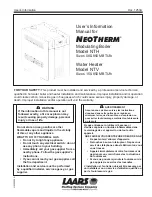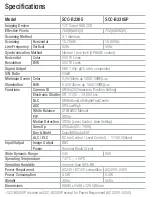
4
• You may use the multiple station interconnected features of your combination
alarm even if powered only by a battery. We recommend that you check with your
local code enforcement bureau before mixing interconnected alarm devices that
may be normally operating both with and without AC power.
• This alarm can share the interconnect wire of smoke and heat alarms. The alarm
will automatically sound a smoke alarm signal if smoke is detected by this unit or
any other interconnected smoke alarm, even if the unit is already detecting carbon
monoxide and sounding the carbon monoxide alarm signal.
WARNING
• DO NOT connect this Smoke/CO alarm to any other type of smoke, CO, heat,
or combination alarm or auxiliary device except those listed in this manual.
• WHILE AC AND AC/DC SMOKE, CO AND HEAT ALARMS CAN BE INTERCON-
NECTED, ONLY WHEN AC POWER IS ACTIVE WILL ALL UNITS ALARM WHEN
ONE UNIT SENSES A HAZARDOUS CONDITION. WHEN AC POWER IS DIS-
CONNECTED, INTERRUPTED OR NOT PRESENT FOR ANY REASON, ONLY
AC/DC UNITS WILL CONTINUE TO SEND AND RECEIVE SIGNALS AND SOUND
AN ALARM IN RESPONSE TO THE PRESENCE OF SMOKE. WHEN POWER IS
DISCONNECTED, INTERRUPTED OR NOT PRESENT FOR ANY REASON, AC
POWERED SMOKE, CO, OR HEAT ALARMS WILL NOT OPERATE!
Compliance and Proper Applications
• This Smoke/CO alarm is designed to be used inside a single-family household. In
multi-family buildings, each individual living unit should have its own alarms. It is
not a substitute for a complete commercial alarm system. It should be used only
as
supplemental
protection in hotels, motels, dormitories, hospitals, nursing
homes, or group homes.
• This product is intended for use in ordinary indoor locations of family living units. It
is not designed to measure compliance with Occupational Safety and Health
Administration (OSHA) commercial or industrial standards.
NOTE: Enclosed with this Smoke/CO alarm are two labels detailing actions to
take in the event of an alarm. One should be placed next to the Smoke/CO
alarm; the other should be placed near a source of fresh air. Please provide the
telephone number of the emergency provider and a qualified technician on each
label.
HOW TO INSTALL THIS SMOKE/CO ALARM
This alarm can be mounted and operated in one of three ways:
1. Battery (DC)
Only Stand Alone,
2.
AC With a Junction Box, and 3
.
Interconnected AC Only and
AC/DC Alarms.
1. Remove the mounting plate. Hold the alarm and turn the mounting plate clockwise
to separate it from the back of the alarm.
2. Hold the mounting plate against the ceiling or wall in the desired position and use
a pencil to trace the inside of the mounting slots.
3. Use a 3/16” (5mm) drill bit to drill through the center of the outlines you made in
Step 2.
4. Insert screw anchors into the drilled holes. If necessary, gently tap anchors with
a hammer until they are flush with the mounting surface.
5. Attach the mounting plate to the mounting surface with the mounting screws
provided.
6. position the combination smoke and CO on the mounting plate and turn
clockwise to lock it into place.
7.
Pull out the battery activation strip.
The alarm will respond with one yellow
light flash.
8. Test the alarm. See “TESTING AND MAINTENANCE” for details.
DANGER
ELECTRICAL SHOCK HAZARD. Turn off power at the main fuse box or circuit
breaker by removing the fuse or switching the circuit breaker to the OFF position.
WARNING
This Smoke/CO alarm should be installed only by a qualified electrician. Carbon
Monoxide alarm installation must be in accordance with the requirements of
Article 760 of the National Electrical Code and any local codes that may apply.
Install alarm on any 4-inch octagon or single gang junction box only.
1. Remove the mounting plate. Hold the alarm and turn the
mounting plate clockwise to separate it from the back of
the alarm.
2. Align recessed slots on plate with mounting holes of any
4-inch octagon or single gang junction box.
3. Gently pull household wires through center hole of plate.
4. Secure plate to junction box using mounting screws.
5. With a wire connector, connect white wire from connector
plug to white (neutral) household wire.
6. Connect black wire from connector
plug to black (120V AC) household
wire.
7.
To interconnect alarms,
connect
yellow wire from connector to
interconnect wire between other
combination or smoke alarms.
Installing a Battery (DC) Only Stand-Alone Alarm
Model FADCM -B
Installing With a Junction Box
Models FADCM and GCM
CAUTION
Do not use super glue or silicon caulk on or near the alarm! Fumes from
these products can coat and permanently damage the sensor.
CAUTION
Do not use super glue or silicon caulk on or near the alarm! Fumes from these
products can coat and permanently damage the sensor.
FOR INTERCONNECT: USE #18 AWG MINIMUM WIRE
YELLOW
BLACK
WHITE
YELLOW
BLACK
WHITE
BLACK
WHITE
TO GROUND
TO 120V AC




























